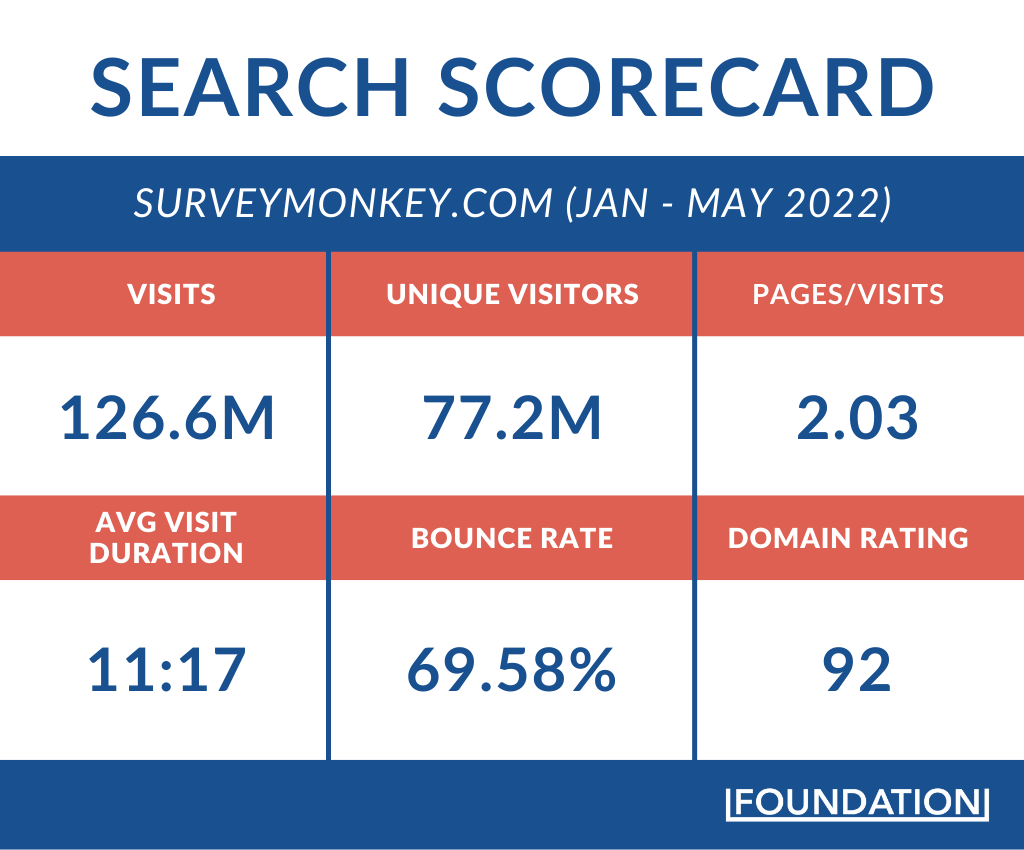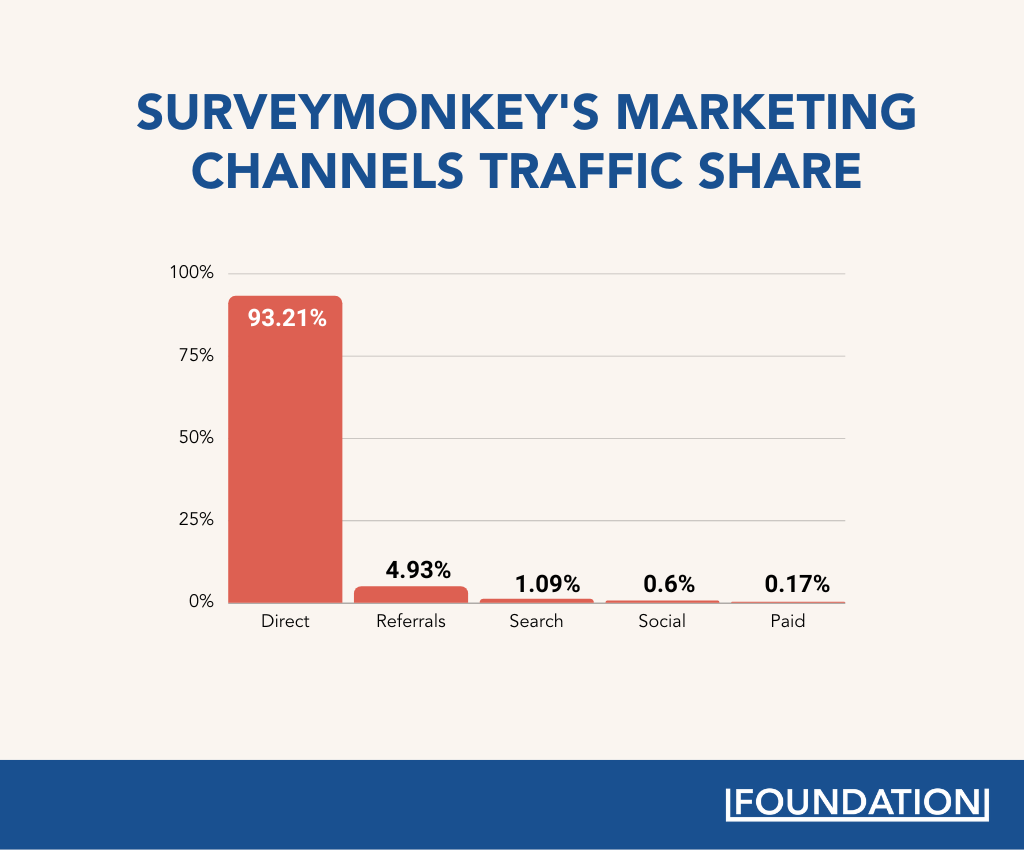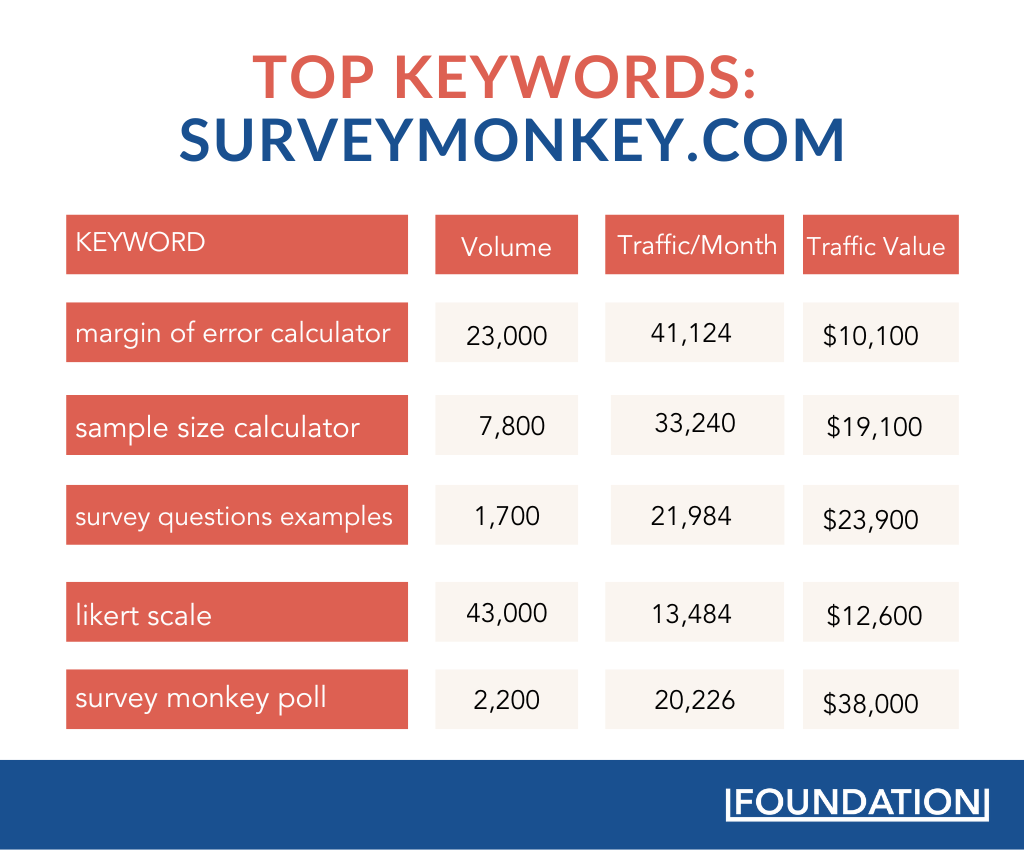Article's Content
SurveyMonkey has conquered the digital survey software launched in 1999 before most Gen Zers were even born, and it’s been crushing the survey software industry ever since. Yet, despite its customer base and market dominance, SurveyMonkey can attribute much of its success to the teeny-tiny details.
See, it’s not always huge campaigns, big teams, or massive marketing budgets that win the market. Sometimes, it’s filling a small, very specific need extremely well. Other times, it’s by letting a seemingly inconspicuous logo do all the marketing work for you.
Or, both, in the case of SurveyMonkey.
These numbers show just how far the brand has come with tiny teams and low ad spend:

In 2021, the company rebranded to Momentive and made SurveyMonkey a subsidiary company next to GetFeedback and Momentive products. Following that move, Zendesk approached the brand to purchase MomentiveAI and its 3 products for $4.1 billion, but the deal fell through when shareholders voted against the acquisition.
Despite the failed acquisition, SurveyMonkey has continued to dominate the survey space, and it does so with an interesting combination of content marketing and referral-based traffic.
Trust us—you won’t see traffic drivers like these on most other websites, making SurveyMonkey the perfect case study for us to explore deeper. Below, we dig into the nitty-gritty to find exactly how SurveyMonkey has conquered the digital survey world for 2 decades running without in-your-face campaigns or huge ad spending.
SurveyMonkey Drives 70+ Million Unique Visitors
Let’s look at a few high-level stats to see where SurveyMonkey is at the time of this writing:

SurveyMonkey drives over 125 million visitors every month, and 70+ million of those come from unique visitors. And these visitors aren’t just passing through. When they arrive, they stay.
The average session duration is 11:17—that’s longer than the average session on popular social networks like TikTok, Pinterest, Reddit, Facebook, and Instagram.

However, the site has experienced a significant dip in organic search traffic over the last 12 months. They had close to 1 million fewer monthly visitors in June 2022 than in June 2021, and you can see that the dip correlates with a sharp drop in organic keywords.

SurveyMonkey ranked for around 1.1 million organic keywords (110,000 page 1 keywords) in June 2021, but that number has dropped to 660,000 organic keywords (70,000 page 1 keywords).
Ironically, this dip is right around when SurveyMonkey rebranded to Momentive, which means they likely lost a few relevant branded keywords in the transition. This is normal after a rebrand, and the numbers usually bounce back and normalize with a bit more time.
Yet, another trend correlates with this dip. You’ll notice that organic traffic and paid traffic follow a similar decline. As the business spends less on advertising, it’s also seeing a drop in organic traffic.
But that’s not stopping SurveyMonkey from bringing in new visitors and customers. Instead, they get most of their traffic from direct and referral sources.
SurveyMonkey Users Do the Marketing for Them
Looking at SurveyMonkey’s sub-par social media presence, we knew something else had to be driving the majority of their traffic. Here’s what we found:

It’s no surprise that the majority of SurveyMonkey’s traffic comes from direct traffic. When you have 19 million active users who know the domain, use auto-fill when revisiting, and have the site bookmarked, that’s almost always going to be the case.
However, we were surprised to find referrals as the second-highest source of traffic, making up an average of 5% of total traffic to the site—and over 10% during some months.
Referral traffic is people who visit a site by clicking a link on another site—that means they didn’t use Google, social media, ads, or an email campaign. They clicked a link from another brand’s website. This could be a link in a product page, blog post, resources page, or tutorial.
Or, in the case of SurveyMonkey, this could be a small linked logo at the bottom of millions of surveys.

The “Powered by SurveyMonkey” footer appears by default at the bottom of every survey design, email invitation, and embedded survey. Users who upgrade their plan can change the footer from mantis green to a more toned-down grey, but they’ll have to upgrade even further if they want to hide the footer completely—and that’s not the tier most users purchase.
Thus, millions of people every day see this gentle call to action. And thousands click it to make up a huge portion of SurveyMonkey’s total referral traffic.
SurveyMonkey doesn’t even have to do any marketing to score this traffic—its users do it for them. And most of them aren’t even free users—they’re paid accounts making SurveyMonkey even more money.
Brilliant.
Whenever you have an opportunity to market your brand—even as small as a logo at the bottom of a survey—take it. It just might become one of your site’s biggest traffic drivers.
Build Tools Your Customers Need
SurveyMonkey’s most valuable piece of content isn’t a blog post, guide, or product page—it’s actually a margin of error tool they let visitors use for free. This built-out page drives thousands in organic traffic every month, and it’s not too complicated to build. Really, it’s a simple calculator at the top with an SEO-optimized description underneath it—that’s it.
Yet, when most brands see keyword opportunities around tools, calculators, presentations, PDFs, and the like, they skip and move on to the next thing. Why? Because it’s easier to write a blog post and takes less collaboration between content marketing, SEO, website, and developer teams.
Instead of passing up the chance (like most competitors), SurveyMonkey seized the day and built out their website’s biggest non-branded keyword traffic driver—and it likely took less than a week to put together.
When approaching your own content marketing strategies, look for projects that nobody else wants to do. If you don’t want to do it, there’s a good chance employees at other companies (in your exact role) won’t want to either. That’s a good sign that you’ll have less competition and more reward if you buck up and get it done.
Look beyond traditional content marketing opportunities. Yes, every brand should have a well-thought-out blog. However, that’s where many brands stop. There are organic traffic and keyword opportunities that go beyond blogging. Don’t be afraid to branch out and tackle something off the beaten path.
Fun Fact: SurveyMonkey’s Blog Isn’t a Traffic Driver
Not at all.
If SurveyMonkey finds a topic with high-volume keywords, they don’t create a blog post for it—they create a standalone page. Everything else goes on the blog.

Looking through SurveyMonkey’s top website pages (in terms of organic traffic), you have to scroll down to page 32 to find your first blog post—and it generates a paltry 1,500 (0.18% of total organic traffic) monthly visitors. In contrast, SurveyMonkey’s margin of error calculator page drives a whopping 23,000 (3.05% of total organic traffic) monthly visitors.
Digging deeper, you’ll find only 10 blog posts in SurveyMonkey’s top 100 traffic-driving pages. Now, that’s not to say the blog doesn’t have a purpose. It does. It’s just not organic search traffic.
SurveyMonkey’s blog, Curiosity, tackles thought leadership topics and downright interesting stuff—that stuff just doesn’t have much organic search value. For example, they post a lot of reports on data they collect using their own products.
Big Keyword Opportunites Require Skyscraper Pieces of Content
Beyond creating tools its customers need, SurveyMonkey also creates special (way more robust) pages for high-value keywords. These aren’t just blog posts they whipped together to compete for traffic—these are hardy pages with specialized formatting and calls to action to make them stand miles above the competition.
For example, look at SurveyMonkey’s Likert Scale page. Pretty, right?
Now, go check out the other top-ranking pages on Google competing for the keyword “Likert Scale.” What’s the difference?
SurveyMonkey’s page is:
- Robust. It’s longer, contains more information, and provides more answers.
- Pretty. Yes, it matters. Competitors’ pages are frankly ugly and poorly formatted.
- Unique. The content here isn’t a hodgepodge of regurgitated information about Likert Scales—it has character and expertise.
- Practical. SurveyMonkey’s page isn’t Webster’s definition of Likert Scales. It contains valuable advice for users to learn when to use Likert Scale questions and how to build them effectively.
It’s no wonder Google ranks SurveyMonkey’s content at the top of its search engine results page (SERP)—and it’s no wonder this page is SurveyMonkey’s second-highest non-branded keyword traffic driver.
Quality always beats quantity when it comes to content marketing. It’s better to produce one piece of killer content than it is to release 100 second-rate pieces. It’s the 80/20 rule—and you’ll find it’s true for just about any marketing program.
Product Expansion Done Right
SurveyMonkey’s brand is brilliant, and they don’t want to muddle the water or confuse potential customers. “Survey” is in the name, and survey is what they do—end of story.
Not sure what the monkey has to do with it, but everyone needs something memorable. Why not a monkey?

SurveyMonkey has 53% of the market share when it comes to site traffic. That’s more than Qualtrics, Jotform, Typeform, and QuestionPro combined.
While that might be due to SurveyMonkey’s history and loyal user base, it also has to do with brand awareness. When someone wants to run digital surveys for their company, and they’ve never done it before, a name like SurveyMonkey will get your attention more than tools like Qualtrics or Jotform.
It’s a small detail with a big impact.
However, that doesn’t mean SurveyMonkey needs to pigeonhole its products and never expand its solutions. Not at all. It just needs to be a bit more intentional, and that’s precisely what they did when they formed parent company Momentive and made SurveyMonkey a subsidiary product beneath it.

This gave Momentive the freedom to release other market research products without hurting SurveyMonkey’s brand.
Want to see what happens when you don’t take this approach? Look at Mailchimp. If we asked you what MailChimp does, you’d probably say email marketing, and you’d be right. Sort of.
See, Mailchimp doesn’t just do email marketing. They also do landing pages, surveys, direct mail, CRM, social media management, and display ads. It’s a pretty awesome all-in-one tool—but non-users don’t know about it because the brand’s name is Mailchimp, and it’s always been an email marketing company.
SurveyMonkey ditched this approach. It does surveys. That’s it. Want something else in a similar realm? Check out Momentive’s other products.
Speaking of Mailchimp, what’s the deal with all these successful primate-based brands? Just saying.
Lessons You Can Take Away From SurveyMonkey
While it’s great to hear other businesses’ success stories, the magic happens when you can borrow their knowledge and grab a win for yourself. Here are a few lessons you can take away from this case study:
- Do things differently: SurveyMonkey wasn’t afraid to ditch the traditional blog-first approach. Instead, they prioritize unique standalone pages to feature the best-of-the-best content. Just because most industries follow a similar pattern doesn’t mean you have to—think outside the box.
- Rake in the referrals: Look for ways to get users to promote your brand (without inconveniencing them, of course). Affiliate marketing and loyalty programs often perform well, especially with the help of ecommerce affiliate software, but look for other non-invasive organic ways to put yourself in front of your customers’ customers.
- Prepare for the consequences of a rebrand: Rebrands have good and bad outcomes—but, hopefully, you’re net positive by the end of all of it. Expect a dip in branded search traffic (and some non-branded traffic) immediately after a rebrand. It’ll take a bit of time to rebound.
- Protect your brand: Just because you can add products and features to your brand doesn’t mean you should. Instead, consider building a sister brand. This can solidify your business offerings, make you a master of a service, and help you avoid jack-of-all-trades labels.
- Name your brand after a primate: It seems to work.
SurveyMonkey has been dominating the survey space for decades, and now they’re expanding into other realms—and they don’t look to be slowing down. If you’d like to experience the same success, learn from their victories and mistakes.







